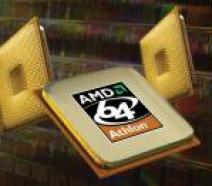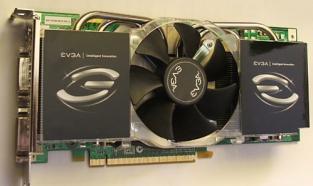INTEL CORE 2 DUO E6550 REVIEW AND OVERCLOCKING
![]()
|
|
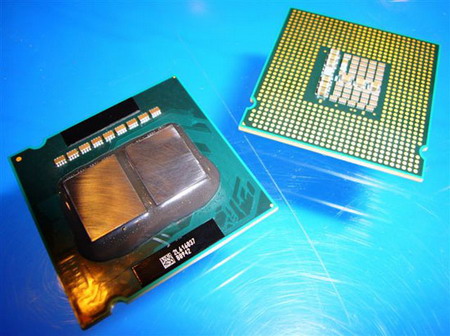 |
||||||||||||
| Posted:2007-08-03 By cpu review Number of View:214801 |
|||||||||||||
By :cpu review Posted:2007-08-03
Intel processors with micro-architecture core use already the system bus 333 (1333) MHz. The scales of new system bus frequency is completely regular and overclocker already reached the frequencies 400 (1600) and 500 (2000) MHz FSB . The minimum multiplier of this new processors remain as previous x7, i.e., So to overclock the new low-end intel processors core 2 Duo e6550 will not be a bit simpler than previous e6300 or E6320. For those who usually overclock their processor, there is not significant advantages from passage with FSB 333 MHz from 266 MHz , test proved that at equal frequency the performance between the two processor (266 MHz) and (333Mhz) is in the best case 1-2%. The only positive side with the new 333 MHZ processor are : increase in the specific performance, higher processors frequency with 4 MB cache volume in the second level and finally ALL this is proposed on the previous prices. Let us also note that new processors energy consumption in the rest state was reduced to 8 W : this noticeable in comparison with 12 W in the previous core revisions (30% saving) , but if we recall that the first processors core consumed 22 W, then the new level is simply amazing. However, as main change for us should be recognized the improvement in the overclocking potential. Overclock to 3.6, to 4 GHz and even higher are submitted daily with new processor , the new revisions noticeably improved the overclock result using air cooling even without increase in the default vcore, moreover this improvement is not only for dual core, but also for four core processors . To check the overclocking capability , we took three processor intel core 2 Duo e6550. They all work on the system bus 333 MHz, their default frequency is 2.33 GHz, they have 4 MB cache in the second level, ALL those processor are assembled in Malaysia and has the marking SLA9X.   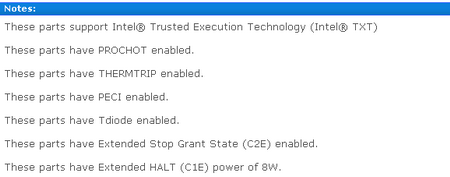 Processors related to one party, but their series numbers differed (by several thousand). Here is the hardware component used for this test:
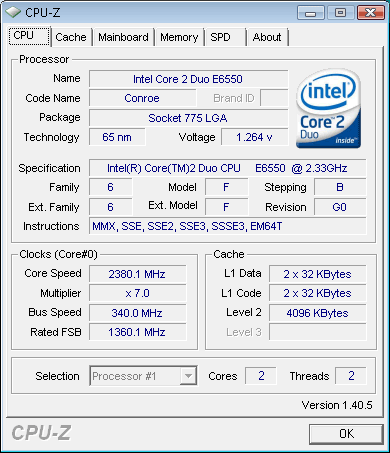 Overstating the default processor frequency is a characteristic property of abit motherboard , this time the processor was working at 47 MHZ Higher than its default ; however, the processor with similar setting functioned without any problems, Here is the motherboard at the idle time (the processor voltage and frequency are decreased) . 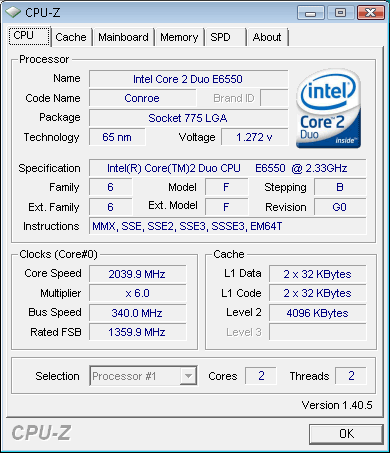 CPU- Z Utility erroneously reflects the current voltage. The widely known program core-Temp not only cannot show the correct temperature, but also make mistakes in the frequencies, and even in the processor name . 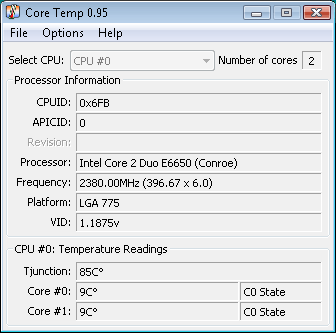 Speed-Fan don\'t show any additional information , the only available value is the hard disk temperature !!!!.  It was necessary then to install the abit utility ( µGuru version 3.1.0.4 ). This utility correctly tracked the change in temperatures and voltage. The default voltage in all tested processors is 1.35 v : this is greater than earlier value encountered with older CPU models and also maximum for this processor. Let us directly pass to the overclock results , the first tested processors without increase in vcore proved to be completely stable and operational at the FSB frequency equal to 480 MHz! 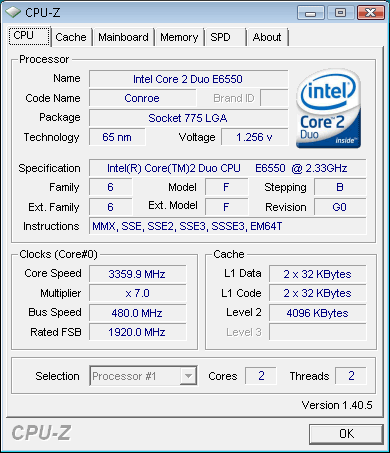 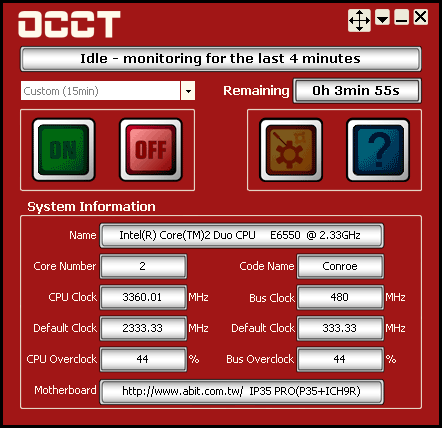 As comparison : the processor intel core 2 Duo e6300, which we usually utilized for motherboard test , was capable to overclock up to 490 MHz, but with increase in the vcore to 1.45 v! Overclock to 3.36 GHz with the default vcore is pretty good result; however, Since the FSB was already high , we should not except a lot higher frequency from this processor due to : FSB wall, motherboard or memory possibility . :-( With FSB 520 MHz the system refuse to boot even with lowered to the minimum (x6) multiplier , with 510 MHz we was able to reach windows but only several seconds after a freeze , then at 505 MHz it was possible to run this processor stability . 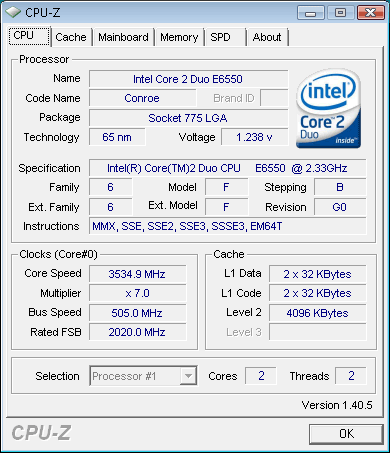 For achieving this result it was necessary to increase the processor vcore from the default 1.35 to 1.45 v, Voltage on the north bridge was also increased from 1.25 to 1.52 v, the CPU VTT was increased from 1.2 to 1.31 v. the temperature during the half-hour checking using OCCT program ( according to abit µGuru utility ) was only 45c. Let us pass to the second processor , we immediately started our test with default CPU vcore and FSB frequency set to 490 MHz. But Here .... !!! The system refused to boot at this frequency and also at 480 , 470 , 460 MHz. So we decreased the multiplier to x6, and the disappointment was that the system refused to boot up at the FSB frequency 450 MHz. This is an example of low FSB Wall value . With 440 MHz FSB the processor was capable to load Windows, but it was not stable in tests, The stability was possible only with 430 MHz. frequency  Possibly, This processor could work at the FSB frequency 435 MHz, but we have not checked for stability with such setting. Last processor proved to be just a little better than the second. It can boot up with 460 MHz frequency but no more , tests can not passe at 455 MHz frequency , The max stable FSB frequency was 450 MHz and also here without increase In vcore.  ConclusionThe results proved that the processors intel core 2 Duo e6550 is not only impressive, but also discouraging. The new G0 stepping actually demonstrate excellent overclock capabilities . From other side, let us note that overclock is just like a lottery u can get a good or bad processor . At the same time we should recognize that the processors intel core 2 Duo e6550 as their predecessors intel core 2 Duo e6300 and E6320, are imperfect selection for overclock. Due to the low default multiplier ( x7 ) witch completely limit their overclocking potential. Overclocker should look for the processors intel core 2 Duo e6750 with x8 multiplier (2.66 GHz). But what if their FSB wall will prove to be limited by the frequency 400 MHz????..... The price of the following model : intel core 2 Duo e6850 (3.0 GHz) will be compared with the cost of low-end four core processor core 2 Quad q6600 (2.4 GHz) .. As far as economical overclockers, which prefer to not expend on the processor considerably more than $100. The choice is limited to the processors intel core 2 Duo e4500 (2.2 GHz) and e4400 (2.0 GHz), working with 200 (800) MHz system bus and based on the new stepping M0 : this the reduced to (2 MB cache) version. Such processor has high multiplier x10 and x11 witch allow to ovoid problem with motherboard , memory and FSB wall Limits .
we would be happy to answer for your question . if you have suggestion or comment
regarding this review our support would be glad to help just join our forum and ask u will get the best answer
to discuss check our forum section :-) RATE THIS REVIEW | |||||||||||||
![]()

7600gt review
7600gt is the middle card range.
We already benchmarked this video card and found that ...

 geforce 8800gtx and 8800gts
geforce 8800gtx and 8800gts  Xtreview software download Section
Xtreview software download Section  AMD TURION 64 X2 REVIEW
AMD TURION 64 X2 REVIEW  INTEL PENTIUM D 920 , INTEL PENTIUM D 930
INTEL PENTIUM D 920 , INTEL PENTIUM D 930  6800XT REVIEW
6800XT REVIEW  computer hardware REVIEW
computer hardware REVIEW  INTEL CONROE CORE DUO 2 REVIEW VS AMD AM2
INTEL CONROE CORE DUO 2 REVIEW VS AMD AM2  INTEL PENTIUM D 805 INTEL D805
INTEL PENTIUM D 805 INTEL D805  Free desktop wallpaper
Free desktop wallpaper  online fighting game
online fighting game  Xtreview price comparison center
Xtreview price comparison center 

- The new version of GPU-Z finally kills the belief in the miracle of Vega transformation
- The motherboard manufacturer confirms the characteristics of the processors Coffee Lake
- We are looking for copper coolers on NVIDIA Volta computing accelerators
- Unofficially about Intels plans to release 300-series chipset
- The Japanese representation of AMD offered monetary compensation to the first buyers of Ryzen Threadripper
- This year will not be released more than 45 million motherboards
- TSMC denies the presentation of charges from the antimonopoly authorities
- Radeon RX Vega 64 at frequencies 1802-1000 MHz updated the record GPUPI 1B
- AMD itself would like to believe that mobile processors Ryzen have already been released
- AMD Vega 20 will find application in accelerating computations
- Pre-orders for new iPhone start next week
- Radeon RX Vega 57, 58 and 59: the wonders of transformation
- ASML starts commercial delivery of EUV-scanners
- The older Skylake processors with a free multiplier are removed from production
- Meizu will release Android-smartphone based on Helio P40
- AMD Bristol Ridge processors are also available in American retail
- The fate of Toshiba Memory can be solved to the next environment
- duo GeForce GTX 1080 Ti in GPUPI 1B at frequencies of 2480-10320 MHz
- New Kentsfield overclocking record up to 5204 MHz
- Lenovo released Android-smartphone K8



computer news computer parts review Old Forum Downloads New Forum Login Join Articles terms Hardware blog Sitemap Get Freebies
